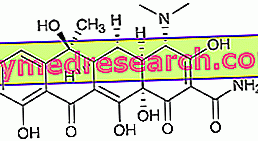Tetracycline is an antibiotic belonging to the tetracycline class. It is produced by fermentation from Streptomyces aureofaciens and related species.

Tetracycline - Chemical Structure
It is a bacteriostatic type antibiotic, meaning it does not kill bacterial cells, but inhibits their growth.
Indications
For what it uses
Tetracycline is used to treat infections caused by bacteria that are sensitive to it.
More specifically, the use of tetracycline is indicated for the treatment of:
- Infections of lungs and bronchi;
- Skin infections;
- Eye infections;
- Ear infections;
- Infections of the nose and throat;
- Bone infections;
- Soft tissue infections;
- Intestinal infections;
- Acute and subacute endocarditis;
- Epidermic cerebrospinal meningitis and purulent meningitis;
- Brucellosis;
- rickettsioses;
- Acute and exacerbated genitourinary infections;
- Infections of the female reproductive system;
- Post-operative infections.
Warnings
The use of tetracycline can favor the development of superinfections caused by bacteria resistant to tetracycline itself or to fungi. These superinfections may need adequate drug treatment.
Tetracycline can decrease the ability of blood to clot.
If treatment with tetracycline is carried out for long periods, regular checks of blood counts and liver and kidney function should be performed.
If tetracycline is prescribed to treat infections caused by beta-hemolytic streptococcus in group A, treatment with the antibiotic should last at least ten days.
Tetracycline can be deposited in the teeth and bones during the period of formation and growth and can alter the tooth color (the teeth can take on a yellow-brown color). Therefore, the drug should not be given to children under 12 years of age.
Tetracycline can cause the onset of photosensitivity reactions, therefore direct exposure to the sun and UV rays is not recommended.
Caution should be used when administering tetracycline in patients with renal insufficiency. In fact, in this category of patients, there may be an accumulation of antibiotic in the bloodstream due to reduced renal excretion. This accumulation can then lead to the onset of liver damage.
Interactions
Concomitant intake of tetracycline and penicillins should be avoided, due to the possible mutual interference that can occur between the antibacterial activities of these two types of antibiotics.
Concomitant administration of tetracycline and antacid drugs containing aluminum, magnesium or calcium should be avoided, as these decrease the absorption of tetracycline itself.
Tetracycline can increase prothrombin time in patients already on oral anticoagulants therapy. Therefore, during treatment with the antibiotic, it may be necessary to reduce the dosage of oral anticoagulant administered.
During treatment with tetracycline, consumption of foods or beverages based on milk or dairy products should be avoided, as these foods are able to reduce the absorption of tetracycline itself.
In any case, it is still advisable to inform your doctor if you are taking - or have recently been - any type of medication, including non-prescription medicines and herbal and / or homeopathic products.
Side effects
Tetracycline can cause various types of side effects, although not all people experience them. This is due to the different sensitivity that each individual has towards the drug. Therefore, it is not said that the undesirable effects will all occur with the same intensity in each patient.
The main side effects that may occur during tetracycline therapy are listed below.
Allergic reactions
Tetracycline, like any other drug, can trigger allergic reactions in sensitive individuals. These reactions can occur with symptoms such as:
- Urticarial skin eruptions;
- Anaphylactoid purpura;
- Angioedema.
If - during treatment with tetracycline - any type of allergic reaction appears, treatment with the drug should be stopped immediately and the doctor should be contacted immediately.
Blood and lymphatic system disorders
The treatment based on tetracycline can favor the onset of:
- Hemolytic anemia;
- Neutropenia, ie decrease in the number of neutrophils in the bloodstream;
- Plateletopenia, ie decrease in the number of platelets in the blood;
- Eosinophilia, that is the increase in the number of eosinophils in the bloodstream.
Skin and subcutaneous tissue disorders
Tetracycline therapy may cause erythematous or maculopapular-type skin rashes.
Gastrointestinal disorders
Treatment with tetracycline can cause nausea, vomiting and diarrhea.
Other side effects
Other side effects that may occur during tetracycline therapy are:
- Loss of appetite;
- glossitis;
- Mucositis.
Additional side effects in children
Treatment with tetracycline, in children under 12 years of age, can permanently alter the color of teeth that turn yellow-brown.
Overdose
No symptoms have been reported following overdose of tetracycline. However, if a tetracycline overdose is suspected, contact your doctor immediately.
Action mechanism
Tetracycline exerts its bacteriostatic antibiotic action by interfering with the protein synthesis of bacteria.
Protein synthesis in bacterial cells occurs thanks to specific organelles called ribosomes. These organelles consist of ribosomal RNA and proteins associated with each other to form two subunits: the 30S subunit and the 50S subunit.
The task of the ribosome is to bind and translate the messenger RNA coming from the cell nucleus and to synthesize the proteins for which it encodes.
Tetracycline binds to the 30S ribosomal subunit, thus preventing messenger RNA from binding to the same ribosome, thus causing the blocking of protein synthesis.
Mode of Use - Posology
Tetracycline is available for oral administration as hard capsules.
The dose of tetracycline administered and the duration of treatment must be established by the doctor, depending on the type and severity of the infection to be treated.
To avoid possible esophageal irritation, the capsules should be taken with the help of plenty of water, in an upright position and at least an hour before going to bed.
In adults and adolescents over 12 years of age, the tetracycline dose usually used is 15-25 mg / kg of body weight. If you have to treat very serious infections, your doctor may decide to increase the dose of tetracycline to be administered.
In children under the age of 12, due to the possible adverse effects that tetracycline can cause (see "Warnings" section), the use of the drug should be carried out only in cases of real need and only under the strict supervision of the doctor .
Patients with renal failure will receive a lower dose of tetracycline than is usually administered.
Pregnancy and breastfeeding
Before taking tetracycline, pregnant women and breastfeeding mothers should definitely seek medical advice.
Due to the possible effects that it may have on the fetus or newborn, the use of the drug by this category of patients should only be done in cases of extreme necessity and only under the strict supervision of the doctor.
Contraindications
The use of tetracycline is contraindicated in the following cases:
- In patients with known hypersensitivity to tetracycline itself;
- In patients with known hypersensitivity to other tetracyclines.



